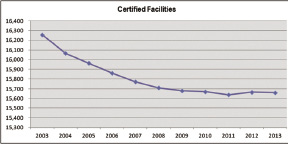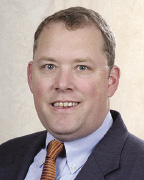For a number of years it has been the focus of governments at both the federal and state levels to put in place cost containments for the care provided by the skilled nursing facilities. Over the years a number of programs have been put in place in a focus to reduce the costs of long-term care to the tax payer while still providing quality care to those in need. The thinking has been if alternative methods such as assisted living and home healthcare were used, the number of people needing skilled nursing care would be reduced and therefore less costly to the various government programs. Has the need for skilled nursing beds been diminished? How does New England compare to the balance of the country?
In the past decade the number of nursing facilities in the United States has decreased from approximately 16,256 in 2003 to 15,659 in 2013. This represents a 3.7% decrease in a 10-year period. Year-end 2013 statistics indicate a total of 15,659 nursing facilities (source American Health Care Association Reimbursement and Research Department, December 2013). The table illustrates the year-to-year change.
In comparison, within New England the total number of skilled nursing facilities totaled 1,018 in 2007 and had declined to 955 in 2013 or a 6.19% reduction which is higher than the national average. Massachusetts and Connecticut had the two highest numbers of reduced facilities at 29 and 15 respectively, followed by New Hampshire (6), Vermont and Maine (5) and Rhode Island (3).
During this same time period the number of skilled beds eliminated from the market totaled 4,482 representing a 4.21% reduction from 2007 levels.
In 2007 the combined occupancy rate in New England was 91.85% with Connecticut having the highest occupancy at 94% and New Hampshire the lowest at 89.4%. As illustrated all of the New England States were above the average for the Nation. In 2013 the Nation posted a 85.7% occupancy. Again, New England enjoyed a higher occupancy rate at 88.19% with Rhode Island having the highest at 91.6% and Vermont at 84.4% at the lower end of the scale.
So with the reduction in nursing facilities and nursing beds, with the exception of New Hampshire, each state also saw a decline in occupancy. There are several sources of revenue for nursing facilities, including Medicaid, Medicare, self-pay or private pay, private insurance and other governmental programs such as the Veterans' Administration. Medicaid is run by the individual states and Medicare is administered by the Federal government. On a national basis we have seen the census for Medicare residents rise from 13.7% in 2007 to 14.4% in 2013. Medicaid has witnessed a reduction from 64.2% in 2007 to 63.1% in 2013 and "other" have seen a slight increase from 2007 to 2013.
New England has seen both the Medicare and Medicaid census being reduced during this same time frame while there has been a shift in occupancy to the "other" category. However the percentage of Medicaid census is above the national average. Connecticut has the largest percentage of it census being comprised by Medicaid at 67.3% while Massachusetts has the least at 62.5%.
Outlook
The national trend has been for both a reduction in number of as well as occupied skilled nursing beds. This too has been the trend for the New England states. Over the years the increase of assisted living facilities as well as home health care has been and is anticipated to continue to have an impact on the occupancy level of the skilled bed inventory in the short term. By doing so, regulators and policy makers alike are hoping that these programs and a move to managed care will help control the demand for and the associated costs of skilled nursing services.
Nursing homes are not going to disappear. With the forecast demographics, it is anticipated that the customer base will be growing over the next several decades. As some in the industry have called this approaching trend a "silver tsunami" it is anticipated that the need for skilled nursing beds will be increasing and reverse the downward trend in both number of beds and occupancy rate.
With the Determination of Need or Certificate of Need policies in place, new inventory entering the marketplace will be controlled. The combination of these factors has resulted in increased interest by a number of operators to position their business plan to meet the anticipated demand in the future years. So while the current trend of reduced number of beds and occupancy levels would suggest a contracting market, many in the industry believe the opposite will occur and are positioning themselves accordingly.
Gerald Rasmussen, MAI, FRICS, is executive managing director/national practice leader for the senior housing and healthcare practice group at Cushman & Wakefield, Stamford, Conn. John Watkins also contributed to this article.
Tags:










